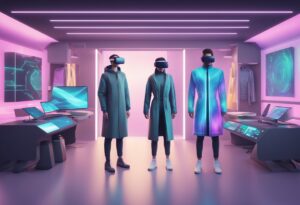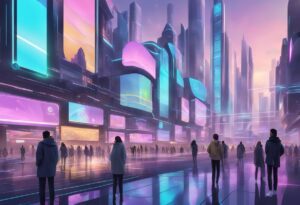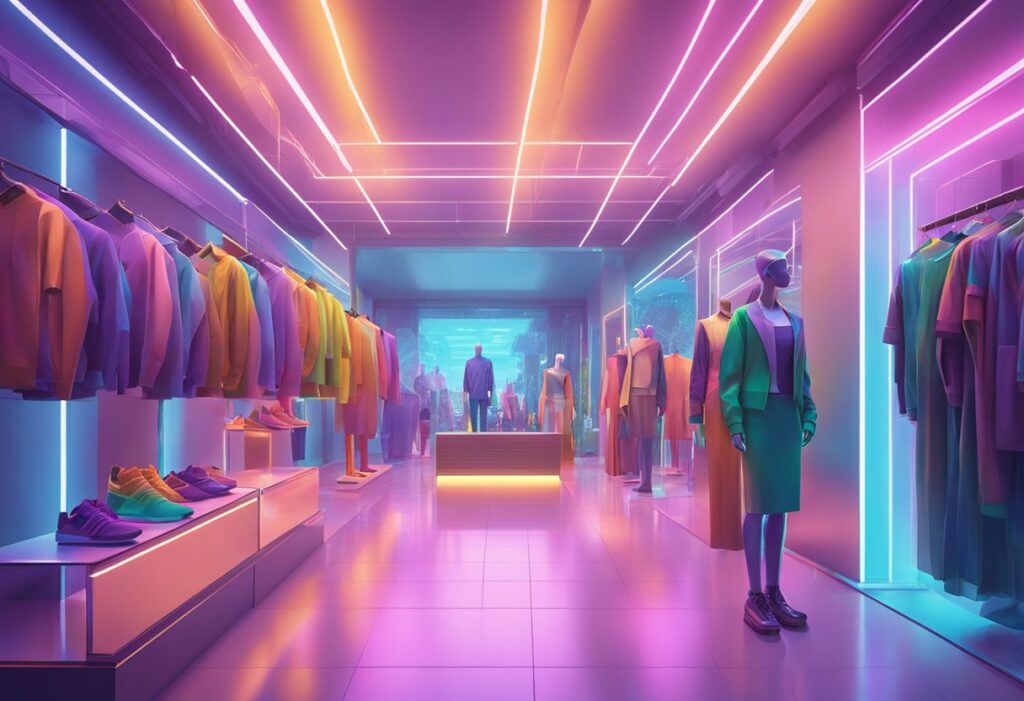Metaverse clothing is a new trend in the fashion industry that has emerged with the rise of the metaverse. The metaverse is a virtual world where people can interact with each other in a digital space. In the metaverse, people can create their own avatars and dress them up with virtual clothing. This has given rise to the concept of virtual fashion or digital fashion.
The fashion industry is taking notice of this trend and is starting to invest in metaverse clothing. Many fashion brands are now creating virtual clothing that people can wear in the metaverse. This has opened up a new market for fashion brands, as people are willing to pay real money for virtual clothing. In fact, some virtual clothing items have sold for more than their real-life counterparts.
Technology has played a significant role in the development of metaverse clothing. Augmented reality (AR) and virtual reality (VR) technologies are being used to create realistic virtual clothing that people can wear in the metaverse. Blockchain technology is being used to create non-fungible tokens (NFTs) for virtual clothing, which allows people to buy, sell, and trade virtual clothing items.
Evolution of Fashion in the Metaverse
From Physical to Digital
The concept of fashion has been evolving at an unprecedented pace in the metaverse. The shift from physical to digital has brought significant changes in the way people perceive fashion. In the metaverse, fashion is no longer limited to physical clothing but has expanded to virtual clothing as well. The virtual fashion market has become a new avenue for fashion enthusiasts to experiment with their style.
Metaverse Fashion Week
The metaverse has given rise to a new event in the fashion industry, the Metaverse Fashion Week. The event showcases virtual clothing designs from various designers and fashion brands.
It provides a platform for designers to showcase their creativity and innovation in the virtual fashion world. The Metaverse Fashion Week has become a significant event in the fashion industry, attracting designers, fashion brands, and fashion enthusiasts from all over the world.
Role of Designers and Brands
Designers and fashion brands have a crucial role in shaping the fashion industry in the metaverse. They are responsible for creating virtual clothing designs that appeal to the fashion enthusiasts in the metaverse. Ralph Lauren, Nike, Adidas, Balenciaga, and Gucci are some of the fashion brands that have already established their presence in the virtual fashion market.
Moreover, the rise of digital fashion houses has given rise to a new breed of fashion designers. These designers specialize in creating virtual clothing designs that cater to the growing demand in the metaverse. The role of designers and fashion brands in the metaverse is pivotal in shaping the future of the fashion industry.
The evolution of fashion in the metaverse has brought significant changes in the way people perceive fashion. The virtual fashion market has become a new avenue for fashion enthusiasts to experiment with their style.
The Metaverse Fashion Week has become a significant event in the fashion industry, attracting designers, fashion brands, and fashion enthusiasts from all over the world. The role of designers and fashion brands in the metaverse is pivotal in shaping the future of the fashion industry.
Technology Behind Metaverse Clothing

The Metaverse is a virtual world where users can interact with each other in a three-dimensional space. With the rise of the Metaverse, a new industry has emerged, which is digital fashion. Digital fashion is clothing that exists only in the virtual world and can be worn by avatars. The technology behind Metaverse clothing is essential to creating and designing digital garments.
3D Design and AI
3D design and AI technology play a crucial role in creating digital garments. AI can be used to generate 3D models of clothing, which can then be refined by designers.
This technology allows designers to create and test multiple designs quickly, which saves time and resources. 3D design technology allows for the creation of virtual prototypes, which can be tested before physical production, reducing waste.
Blockchain and Smart Contracts
Blockchain technology and smart contracts are used to authenticate and verify digital garments. Blockchain technology provides a secure and transparent way to store data, which is crucial for digital fashion. Smart contracts can be used to ensure that digital garments are unique and cannot be duplicated.
This technology is essential for the creation of NFTs (non-fungible tokens), which are unique digital assets that can be bought and sold.
Augmented Reality Integration
Augmented Reality (AR) technology is used to integrate digital garments into the real world. AR technology can be used to create virtual dressing rooms, where users can try on digital garments before purchasing. This technology allows users to see how a garment would look on them without physically trying it on.
AR can be used to create virtual fashion shows, where users can watch models walk down the runway in digital garments.
The technology behind Metaverse clothing is essential to creating and designing digital garments. 3D design and AI technology, blockchain and smart contracts, and AR integration are just a few examples of the technologies used in the creation of digital fashion.
As the Metaverse continues to grow, the digital fashion industry will continue to evolve, and new technologies will emerge.
The Rise of Digital Fashion Brands

As the metaverse continues to expand, digital fashion is becoming increasingly popular. Established fashion brands are entering the metaverse, while new players and startups are also emerging. Collaborations and partnerships are also being formed to take advantage of this new market.
Established Brands Entering the Metaverse
Leading fashion brands such as Nike, Adidas, Balenciaga, and Gucci are entering the metaverse to offer digital clothing for avatars. These brands are leveraging digital fashion to reach a wider audience and offer more personalized experiences to their customers.
By creating digital-only fashion collections, they are able to experiment with new designs and styles that would be impossible to produce in the physical world.
New Players and Startups
Digital-only fashion brands such as DressX are emerging to offer a new way of experiencing fashion. These brands are creating NFT-based digital clothing that can be worn by avatars in the metaverse.
By using blockchain technology, they are able to offer limited edition items that are unique and valuable. These brands are also more sustainable as they do not require physical production or shipping.
Collaborations and Partnerships
Collaborations and partnerships are also being formed to take advantage of this new market. Decentraland, a virtual world built on blockchain technology, has partnered with several fashion brands to offer digital clothing for avatars. These collaborations allow fashion brands to reach a wider audience and offer more personalized experiences to their customers.
The rise of digital fashion in the metaverse is a trend that is here to stay. Established fashion brands, new players and startups, and collaborations and partnerships are all contributing to the growth of this market. As the metaverse continues to expand, we can expect to see even more innovation and experimentation in the world of digital fashion.
Consumer Interaction and Experience in the Metaverse

The metaverse is a virtual world that allows users to interact with each other in a variety of ways. One of the most exciting aspects of the metaverse is the ability to create and customize avatars, allowing users to express themselves in new and unique ways.
Avatars and Identity
In the metaverse, avatars are the representation of users. They can be customized to reflect the user’s preferences, personality, and style.
This provides users with the freedom to express themselves in ways that may not be possible in the physical world. The ability to create a unique identity and engage with others in the metaverse is a significant draw for many users.
Virtual Stores and Showrooms
Virtual stores and showrooms are becoming increasingly popular in the metaverse. These stores provide users with the ability to browse and purchase virtual outfits and accessories.
The benefit of virtual stores is that they offer a unique shopping experience that is not possible in the physical world. Users can try on virtual outfits, mix and match different pieces, and even see how they look in different environments.
Community and Social Engagement
The metaverse is also an excellent platform for community and social engagement. Users can interact with each other through social media platforms, virtual events, and even virtual clubs. This provides users with the ability to connect with like-minded individuals, share ideas and experiences, and form new friendships.
The metaverse offers users a unique and exciting way to interact with each other and express themselves. The ability to create a unique identity, browse virtual stores, and engage with others in a social setting is a significant draw for many users.
Sustainability and Ethical Considerations
As the fashion industry continues to explore the opportunities presented by the metaverse, it is important to consider the potential environmental and ethical impacts of this new frontier. This section will examine some of the ways in which metaverse clothing can be made more sustainable and ethical.
Reducing Carbon Emissions
One of the key advantages of metaverse clothing is that it does not require physical production or transportation, which can significantly reduce carbon emissions.
By creating digital clothing that can be worn in virtual environments, designers can reduce the environmental impact of the fashion industry. However, it is important to note that the energy required to power the servers and devices used to access the metaverse must also be taken into account.
Sustainable Digital Collections
Metaverse clothing can also be made more sustainable by creating digital collections that are designed to last. By creating high-quality digital clothing that can be worn across multiple virtual environments, designers can reduce the need for consumers to constantly purchase new items. This can help to reduce waste and promote a more sustainable fashion industry.
Ethical Production in Virtual Environments
The metaverse also presents an opportunity to create a more ethical fashion industry. By creating virtual production environments that prioritize fair labor practices and sustainable materials, designers can create clothing that is both ethical and sustainable. By using blockchain technology to track the supply chain of virtual clothing, it is possible to ensure that the materials used are ethically sourced and that workers are paid fairly.
The metaverse presents an opportunity to create a more sustainable and ethical fashion industry. By reducing carbon emissions, creating sustainable digital collections, and promoting ethical production in virtual environments, designers can create clothing that is both fashionable and responsible.
Frequently Asked Questions
How can I try on clothes in the metaverse?
Trying on clothes in the metaverse is similar to trying them on in real life. Users can create avatars and use them to try on virtual clothing items. Some metaverse platforms offer virtual dressing rooms where users can try on clothes before purchasing them. Others allow users to upload photos of themselves and use them to create a digital representation of themselves wearing the virtual clothing items.
Which brands have a presence in the fashion metaverse?
Many brands have already established a presence in the fashion metaverse, including Gucci, Balenciaga, and Louis Vuitton. Some brands have even launched virtual clothing lines that are only available in the metaverse. Other brands have partnered with metaverse platforms to create virtual storefronts where users can purchase digital clothing items.
What is the average cost of clothing in the metaverse?
The cost of clothing in the metaverse varies depending on the brand and the item. Some virtual clothing items can be purchased for as little as a few dollars, while others can cost hundreds or even thousands of dollars. Virtual clothing items are often priced similarly to their real-life counterparts.
Where can I purchase metaverse clothing?
Metaverse clothing can be purchased through virtual storefronts on metaverse platforms. Some brands have also launched virtual clothing lines that are only available in the metaverse. Users can also purchase digital clothing items through online marketplaces that specialize in metaverse goods.
What is the role of the Metaverse Fashion Council?
The Metaverse Fashion Council is an organization that was established to promote and regulate fashion in the metaverse. The council works to establish standards for virtual fashion items and to promote ethical and sustainable practices in the production of virtual clothing items. The council also hosts events and initiatives to promote the growth of the fashion metaverse.
How was the Metaverse Fashion Week 2023 significant?
Metaverse Fashion Week 2023 was significant because it showcased the growing importance of fashion in the metaverse. The event featured virtual fashion shows, product launches, and panel discussions on the future of fashion in the metaverse. The event attracted a large audience and generated significant media attention, highlighting the growing interest in the fashion metaverse.














